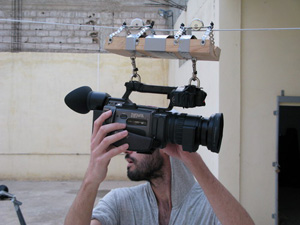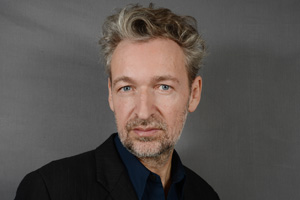What are you doing next weekend? Make time to drop by Cinnamon Colomboscope, which begins on Friday – August 21. This year’s Colomboscope finds it focus in Slave Island, and between the arts programme Shadow Scenes and the talks and literature programme there’s something here for everyone.

Pedro Gomez-Egana: To use Rio’s rooftop for his ‘observatory’
We’ve picked a few exhibits and segments to preview – these are just a handful among the many that you’ll find on the programme, which has been carefully devised by curators Menika van der Poorten, Natasha Ginwala and Radhika Hettiarachchi. For full details and the complete programme see www.colomboscope.lk

Mahen Perera: Finding objects
The Uncle-Shamalee and Alain Parizeau
The Parizeaus seem comfortable making their way around the total darkness of the Rio Hotel on the day we visit. Their room (each artist has been allocated a room for their work) is a stark contrast to the dusty, dirty confines outside. ‘The Uncle’ is an installation that the duo devised with the idea of your quintessential Sri Lankan uncle in mind-“the guy that we all know,” explains Alain. “Sometimes your friend, sometimes the creep, but mostly the old guy at an interesting time of their life.”

Eric Reinhardt:Hum-our and satire
The room is artfully arranged (in a neater fashion than the uncles you and I know will ever adopt) with ratty chairs, magazines (back copies of Readers Digest stacked next to well-worn shoes) and old photos of men of a certain age with their faces obscured for anonymity. A Barbara Cartland novel (mysterious, these uncles) jostles for space among the memorabilia. Shamalee has written several pieces that dominate the room-one, a bittersweet recollection of an old tuition master on the wall, another scribbled on a postcard tucked into an old photo frame. The installation is an unusual ode to the theme of urbanity and displacement that this year’s Cinnamon Colomboscope focuses on.

Dr. Asoka de Zoysa: Walking around Slave Island
Untitled-Mahen Perera
Mahen is not quite sure what his installation will look like because he hasn’t exactly got around to it yet. But he knows what he wants to do-three exhibits made in his trademark style with found objects that he finds immensely inspirational. ‘Found objects’ refer to material that he finds lying around or has sought out from waste-metal, wood, cloth, etc. The artist works with these materials to create installation pieces that are mysterious and assume shape according to the beholder’s perception.
Mahen won’t, unfortunately, be using material from Slave Island due to time and budget constraints but he’s excited to be showing his work at the Rio. “The rooms provoke you,” he says. “It has such charm and character and that’s very good when you’re looking for inspiration.”
The Vimana Kiranaavarta Observatory-Pedro Gomez-Egana
Columbian artist Pedro Gomez-Egana practises across the board with performance, sculpture, video installation and sound works. Gomez will use Rio’s rooftop for his ‘observatory’, which will bring together elements of local geo-history, cosmological fiction and mechanical transmission.

Jonathan Cox: Exploring city lives
Exploring Slave Island-Dr. Asoka de Zoysa
Dr. de Zoysa’s fondness for exploring the city on foot will definitely win you over, we’re guessing about five minutes into this walk. Drawing from the European tradition of taking tours through a historical area on foot, Dr. de Zoysa hopes to engage with the city’s ever changing landscape via the walk. He’s also slightly nervous-“we’re walking through communities and into people’s lives,” he worries. “I don’t want to be intrusive.”
Yet these walks are about the people as much as they are about the landmarks that Slave Island has to offer. The city was christened as ‘Slave Island’ as it used to hold slaves from Africa during the rule of the Portuguese and the Dutch. Principal home to the Beira Lake, a water body that forms an integral part of Colombo’s landscape, Slave Island (or Kompannya Veediya) is a highly commercial area on the cusp of multi-billion rupee development initiatives. The vibrant multi-cultural community of the city is part of its charm, as are heritage buildings like the Castle Hotel, the mosque that has survived vigorous commercial development efforts and the old (now defunct) Nippon Hotel famous for its short eats.
Narrating City Lives-Jonathan Coe, Eric Reinhardt
British satirist Jonathan Coe and French novelist Eric Reinhardt will read from their novels and explore the use of humour and satire in portraying the lives and aspirations of city people. Keith Davis will moderate. Bound to inadvertently make you laugh at yourself, but with luck you won’t realize that till later.
While you’re in Slave Island check out:
The Castle Hotel: Undeniably dodgy yet spirited, the Castle Hotel is one of the last standing buildings against the tide of development taking over Slave Island. Don’t go upstairs. Yapane Bath Kade: Purveyor of all things good when it comes to rice and curry, although it’s probably a better idea to pick up your food on the go. Unless you like sticky table tops and rustic charm-in which case do go ahead.
Rio Hotel rooftop: The view of Colombo from this vantage point is hard to beat. Wear practical shoes, because navigating the stairs is tricky business. Cinnamon Colomboscope is organized by EUNIC Sri Lanka, representing Institut Francais, the Goethe Institut and the British Council.


